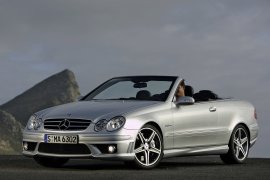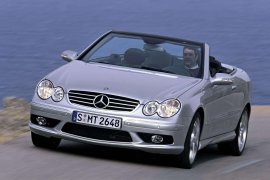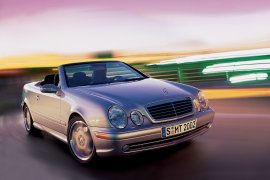MERCEDES BENZ CLK AMG Cabrio Models/Series Timeline, Specifications & Photos
First production year: 1999
Engines: Gasoline
Body style: Convertible (spider/spyder, cabrio/cabriolet, drop/open/soft top)
The power-war was on, and Mercedes-Benz didn't want to lose it in front of its traditional competitor, the BMW M3 convertible.
When BMW introduced the E46 M3 Convertible with 343 hp from a 3.2-liter engine, it was considered an outrageous open-top vehicle. But Mercedes-Benz answered with the CLK AMG Cabriolet. It was the first Mercedes-Benz with an engine developed from scratch by AMG, and what an engine it was.
The exterior of the CLK 63 was heavily revised from the rest of the CLK Cabriolet. At the front, an A-shaped grille in the apron and a pair of side-scoops enhanced the aggressive look of the car. Its slightly wider fenders made room for fatter tires on 18" light-alloy wheels with a unique, five double-spoke design. In the rear, the carmaker installed a double oval-shaped exhaust.
The interior was carried over from the regular CLK, with more aluminum trims and the new COMMAND 2.0 infotainment system, which sported a DVD-based navigation system. It also allowed an iPod integration via an external port installed in the glove compartment. The center stack design was modified, and the former commands carried over from the C-Class were replaced with newer ones.
Under the hood, AMG dropped a 6.2-liter V8 paired to a standard 7-speed automatic (dual-clutch) gearbox that sent the power to the rear wheels. Its performances were far better than those of its main rival, and it wasn't the most spectacular nor the most powerful version of the CLK.
Mercedes-Benz introduced the second generation of the CLK at the 2002 Geneva Motor Show and, a year later, Mercedes-Benz brought the full performance version.
When the German carmaker decided to introduce an AMG version, it didn't think about small engines. It went big all the way and stuffed a 5.4-liter V8 under the hood. But the car went through further modifications to fit the AMG profile.
The carmaker didn't want to make the CLK Cabrio as a sports car. It was more of an open-top grand tourer, suitable to cover long distances in short times. Compared to the regular CLK Cabriolet, the AMG version featured a different apron at the front, with an A-shaped lower grille. In the rear, the Mercedes-Benz special department installed a small spoiler on the trunk lid. As proof that AMG didn't want to go wild all the way, the car featured a twin exhaust, just like a regular 200 Kompressor version.
Inside, the CLK 55 AMG featured a black interior with aluminum accents. The leather upholstery was fitted as standard, and so was the automatic gearbox placed on the center console. On the instrument cluster, the carmaker replaced the black panel from other versions with an aluminum.
Most of the car's credits went to the engine, carried over from its predecessor, but revamped. It grew with 20 hp, from 347 hp to 367 hp.
After introducing the CLK range, Mercedes-Benz brought the open-top version for it together with an AMG-tuned version in 1999: the CLK 55.
Based on the same platform as the Mercedes-Benz C-Classe (W202) but with styling elements from the E-Class (W210), the CLK filled the need for a premium coupe after three years since the dismissal of the C124/A124 series. But the German carmaker didn't have a proper engine to compete against its main rival, BMW, and it asked AMG to build one. And they did more than that.
Compared to the rest of the CLK range, the AMG version sported a different front bumper with a stretched lower grille from side to side and incorporated the fog lights. Its Xenon headlights featured clear lenses as standard, unlike the rest of the range, which had halogen lamps. The aerodynamically profiled side sills were utterly different, while a set of five-spoke 17" light-alloy wheels matched the sporty appearance. The carmaker protected the power-operated roof under a tonneau cover behind the rear seats, which slightly pushed them forward compared to the coupe version.
Since it was based on the W202 platform, which featured a shorter wheelbase than the E-Class sedan, the A208 couldn't offer the same interior room. But for the front occupants, it provided enough space. On the dashboard, the speedometer sported the AMG badge in the middle. Three additional LCDs took the lower part of each of the three dials.
Under the hood, AMG prepared a 5.5-liter, hand-built V-8 engine. It produced 347 hp, which were sent to the rear wheels via a five-speed automatic gearbox improved by AMG over the standard 5G-Tronic Mercedes-Benz gearbox.


